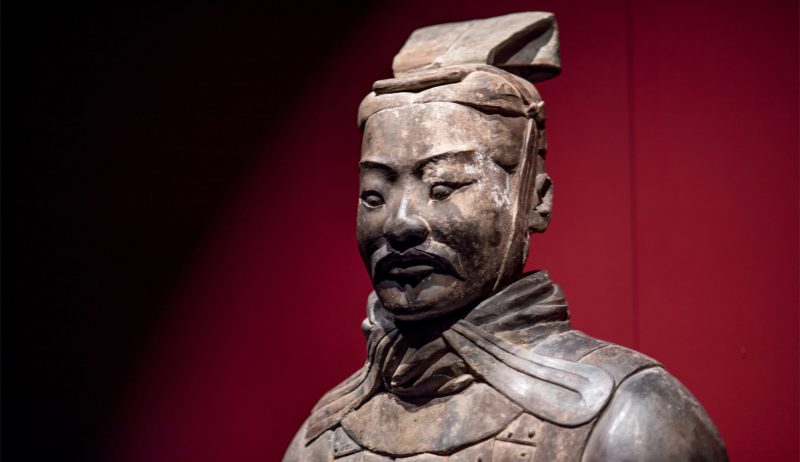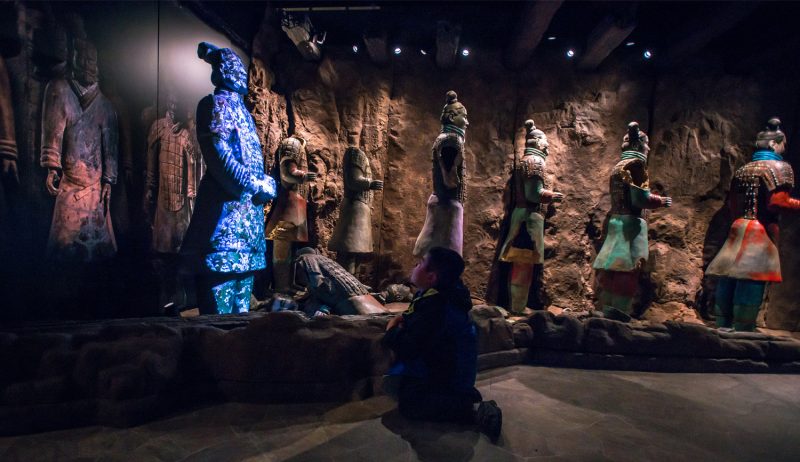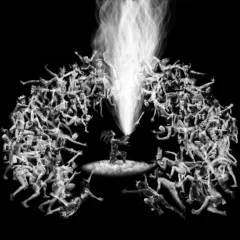A Chinese army has landed simultaneously at two East Coast cities with differing tactics. “Terracotta Army; Legacy of the First Emperor of China” at the Virginia Museum of Fine Arts in Richmond (VMFA) through March 11, 2018 is about a much grander idea than an 8000-troop terracotta army – splendid and overwhelming though that is. The exhibition explores the towering ambition and extraordinary administrative accomplishments of one man, Ying Zheng (259-210 BC), the first Emperor of China (Qin Shihuang). He wanted to rule the entire territory of China – and succeeded. He hoped to continue his reign for eternity. There he failed – but as a backup he planned to rule in the afterlife, hence his 8000 terracotta soldiers.

First Emperor of China unified country and conscripted workers to build roads and extend Great Wall
The Qin king, Ying Zheng’s military victories over the six other competing states of China in 221 BC, ended the centuries-long period known as the Warring States. The self-proclaimed First Emperor understood that a unified empire required security – hence he removed barriers between the previous states and unified and greatly extended the Northern wall — the Great Wall. He understood the need for communication – to which end he built a system of roadways across his empire and standardized and simplified the written language to the form still in use. He created a centralized administrative system, reconfigured the legal system, standardized weights and measures and created a common currency. He also guaranteed a unified, Qin culture by destroying the former states’ private collections of historical records and poetry. His imperial system survived more than two thousand years and many aspects of its hierarchical organization are still in effect.
To accomplish his ambitions Qin Shihuang conscripted a million workers – a tenth of the population and the largest group ever mobilized. They constructed the Great Wall, built shrines and palaces, and built and outfitted his mausoleum. Its discovery in 1972 was one of the greatest archaeological finds of the 20th century, and has spawned ongoing research and numerous exhibitions.
The art historical and archeological exhibit at the VFMA
The Richmond exhibition, organized jointly by Li Jian from the VMFA and Hou-mei Sung of the Cincinnati Art Museum with the cooperation of fourteen collections in Shaanxi province, includes 130 objects, ten of which are the life-sized terracotta figures – nine men and a horse — that give the exhibition its title. It traces the history of the First Emperor’s accomplishments, examines Qin culture–including objects from earlier periods and ideas absorbed from neighboring cultures — and presents objects and information revealed by the excavations at Quin Shihuang’s mausoleum at Xianyang, a 13,900-acre site. The exhibition gives a textured idea of the life of Qin Shihuang’s period, from the great public monuments and ritual objects to the everyday furnishings of both the elite and ordinary citizens.

Lifelike extraordinary warriors and objects of the period
The life-sized terra cotta soldiers are truly extraordinary and unprecedented in their scale and realism. Each is outfitted with gear appropriate to his rank and position, with armor, boots, hairstyles and facial hair depicted in extraordinary detail. The sole of the kneeling archer’s shoe reveals treads to give him traction and the horse’s braided tail and tack reveal every buckle and rivet. They were originally covered with polychrome lacquer which would have made their realism even more startling. I am astonished to think of the worldly army needed to defend Qin Shihuang’s empire while such a huge workforce was creating his otherwordly defense.
I particularly enjoyed various objects which revealed aspects of Qin life, such as a two-inch long silkworm made of bronze; archaeological evidence dates silk production in China to as early as 5000-3000 BC, and by the Qin dynasty sericulture was as important as agriculture. People sat on mats on the floor which were kept in place with weights; the exhibition included a bronze pair in the form of deer whose bodies were formed of spotted seashells, and another, single weight of gilded bronze in the form of a reclining tiger. A highly-decorated bronze beam cladding was used to hold the wooden architecture together before the development of wooden joints. The exhibition labels are particularly good in explaining each object’s function and often describe historical aspects of its form.
Family-friendly exhibit at the Franklin Institute focuses on ancient technology
The artifacts in “Terracotta Warriors of the First Emperor,” on view at the Franklin Institute, Philadelphia through March 4, 2018, are drawn from the same archaeological site and from many of the same museums as in Richmond. It has an equal number of warrior figures and somewhat more of the other artifacts. There is significant overlap of the objects presented – in some cases they might be identical twins – although the Philadelphia exhibition looks entirely different and gives more attention to the technology of the period, and was also more clearly designed for family visits. It was jointly organized with the Pacific Science Center, Seattle.
The Philadelphia exhibition begins with the excitement of the tomb discovery, then introduces information about Qin Shihuang and his empire as it proceeds. It includes a useful, didactic model showing figures about 9 inches high working at each step in the highly-organized process of assembling the terracotta army. I wish the model hadn’t been given a surface similar to that of much of the archaeological material, which made for some confusion from a distance, before reading the label. The exhibition uses music throughout and includes a full scale reproduction of part of the mausoleum with terracotta warriors in various states of preservation – presumably to create drama, as if they didn’t trust the actual artifacts to do so.

Photo-enlargements cover many of the walls, with computer didactics and video throughout and several hands-on stations addressed to the manufacture of the terracotta figures, probably intended for children; I did not attempt to assess them. I found the Philadelphia presentation harder to follow than Richmond’s. Both exhibitions look as though their checklists were largely pre-selected by the Chinese lenders according to an algorithm that each exhibition include ten large terracotta figures, as has been true with exhibitions of this material elsewhere; the reasons for the other loans are much less clear, although the curators at Richmond did a better job with what they were offered and produced a handsome and useful catalog worthy of a serious museum.
Video conveys excitement of archeological discovery
As an art historian I was frustrated that the Franklin Institute presented very little information about individual objects beyond the clay army, as if archaeological materials were there merely to illustrate a story line and did not themselves carry information. They presented multiple examples of bronze vessels and a sequence of clay vessels modeled after bronzes without an explanation of the relationship of one example to another. And I am baffled by the substantial group of Han burial figures at the end of the exhibition; they made the point that the Han reverted to earlier and simpler burial practices than their Qin predecessors, but a label would have sufficed for that. I thought the most interesting educational tool was a video of conservators cleaning some newly-excavated objects; it really did bring some of the excitement of the discovery to life.
Terracotta Army at the Virginia Museum of Fine Arts, to March 11, 2018
Terracotta Warriors at the Franklin Institute, to March 4, 2018









